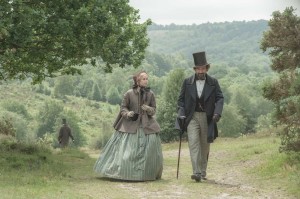
Following the film, a Q&A session allowed Fiennes and producer Gabrielle Tana to recount their journey from pre-production to post on their follow up to Coriolanus. Neither Fiennes nor Tana expected their next film to be a period piece. Fiennes knew relatively little about Dickens entering pre-production.
“I knew his stories, of course, from adaptations and films, had read one Dickens novel, but didn’t know anything about his life except that he liked to read his own works and was a family man,” said Fiennes. “But this script really got under my skin.”
Tana expressed feeling relieved when Fiennes agreed to be involved with the film.
“Parts of production were extremely easy in that I was working with Ralph who I knew would be able to do a magnificent job with it, which was what kept me going,” said Tana. Their biggest challenge was making sure period specific props and costumes were accurate and that Fiennes had enough time to both direct and act.
 Fiennes and Tana explained costume designer Michael O’Connor’s purist approach to detail and accuracy. Both had worked with O’Connor previously on the 2008 film The Duchess.
Fiennes and Tana explained costume designer Michael O’Connor’s purist approach to detail and accuracy. Both had worked with O’Connor previously on the 2008 film The Duchess.
“He’s detailed to a wonderful and masochistically exquisite fault. He’s still researching delicate fabrics when you’re shooting tomorrow,” shared Fiennes. “There’s a black satin waistcoat with tiny grapes and vine leaves embroidered in the lapel. That’s actually a period waistcoat, it’s the real deal.”
Fiennes and director of photography Rob Hardy chose a 2.35:1 format, shooting with 35mm Kodak and Fuji film. Using 50mm, 70mm and 85mm anamorphic lenses, mediums and closeups were a priority to evoke a position of observation and intimacy.
“I wanted the camera to be in positions of observation,” explained Fiennes. “When I met Rob Hardy, what excited me about his work was his compositional strength… that grew on our location scouts because he took amazing stills. I felt his eye was really exciting and unusual. He was interested in the backs of people as well as the fronts.”
Nearly all of the locations in Britain were real. The Ternan house was shot on a location frequented by film productions which attracted Fiennes in regards to its lived in look. Fiennes and Tana also made use of an alleyway set from the Harry Potter films and built only one set otherwise – a period appropriate train car that was moved by a gimbal.
When asked about the reserved score, Fiennes praised composer Ilan Eshkeri for his support on letting sound effects and foley lead the soundtrack.
“I love it when I see a film that has no music,” said Fiennes. “I don’t like it when music is telling me what I should be feeling. I want to find my feelings myself.”
Fiennes and Tana spoke of future collaboration. Regarding this Tana said, “There are a couple of things we’re developing. Whatever Ralph wants to do I’ll help him do.”
The Invisible Woman will be in theaters Dec. 25.





